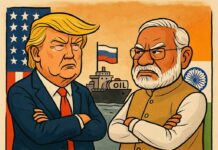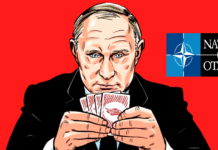Over the past three decades, the world has witnessed a dramatic shift in the global balance of power. First with the collapse of the USSR, then the decline of US hegemony and the rise of new geopolitical players like China and India, India’s foreign policy has steadily evolved from a non-aligned stance to a more assertive and independent global presence. This transformation is not just a reflection of India’s growing economic might but a calculated strategy designed to counterbalance American dominance in global affairs. With its huge population, prosperous economy and strategic location, India has long been a regional superpower. However, its quest to reshape the global order are gaining new momentum, especially in the context of recent foreign policy developments. From strengthening ties with China and Russia to courting key nations in the Global South, India’s evolving stance presents a subtle but clear challenge to American supremacy.

In the aftermath of the Cold War, the United States enjoyed a period of unrivaled hegemony. This is why in the 1990s and early 2000s, the US dictated the terms of the global order, from economic policies to military interventions, with a military footprint spanning continents and an unwavering grip on international finance. However, the events of the past decade have signaled the unraveling of this unipolar moment. America’s wars in Iraq in the name of Weapons of Mass Destruction (WMD) and feeding the terrorism in Afghanistan, its economic collapse in 2008, the formation of the BRICS alliance, and recent debacles in global trade and Hypersonic Missile Technology have greatly tarnished the US image as an almighty power.
Moreover, experts are deriving many speculations from President Donald Trump‘s 50 percent tariffs on India, the most prominent of which is the purchase of crude oil from Russia. But as analyst I think the real motive behind this tariff is the fear of India’s strategic autonomy, due to which President Trump has taken this forward step. This fear has come to the fore in recent years, first of all, under former President Joe Biden, despite heavy pressure from the US and the European Union, India not only continued to buy crude oil from Russia, but also increased imports manifold. Although, India has saved billions of dollars from cheap Russian oil in the last few years, petrol-diesel has not become cheaper for the common consumer.

Now, even after heavy pressure from President Trump, India did not open its Agriculture and Dairy sector for the US market, and also in the war between India and Pakistan, India neither gave any credit to US President Trump, nor nomination for the Nobel Prize, even clearly rejected the purchase of F-35 fighter jets, which was promoted by both President Trump during Prime Minister Narendra Modi‘s US visit and Vice President JD Vance during his visit to India. These are the reasons why President Trump has taken unilateral and irresponsible action against a strategic partner like India to save his image among die-heart supporters, while other side he is engaged in giving waivers in tariff to China. In fact, the whole world knows that the biggest buyer of Russian crude oil is not India, but China; and the biggest buyer of LNG is the European Union, which is feeding Russia’s war by making purchases worth hundreds of billions of dollars. Now even G-7 countries like Japan have started buying crude oil from Russia after two years.
President Trump is not capable to understand to what extent he has damage the relations between India and America. Most Indians already had doubts from years about America’s friendship, and now this pure capitalist American deception will make Indians see America as half friend and half enemy for a long time. Trump will not be able to hide for long behind this main reason, how America’s sweet dreams destroyed a developed and prosperous nation. Due to American provocation, Ukraine is not only losing thousands of kilometers of land, but thousands of soldiers have lost their lives and millions of citizens have to bear displacement. In the coming decades, these will be some of the reasons that will lead to American supremacy’s downfall.

In fact, Trump has given India a great opportunity to assert its strategic autonomy, which India has always wanted to do. India’s growing global ambitions are not about direct confrontation with the US, but about challenging the principles that have defined US dominance, and fostering a multipolar world. This multipolarity is not merely a theoretical concept; it is a reality that India is working to shape, and this will also complement its strategic autonomy. It will also become a trusted partner for the Global South and an inspiration for the multipolarity theory.
One of the most significant developments in India’s foreign policy has been the strengthening of its ties with Russia and China. Despite growing US pressure to isolate Russia over the Ukraine war, India has maintained a pragmatic approach and continued to buy Russian oil and military equipment, putting national interests at the forefront. In its relations with China, India has adopted a nuanced strategy. Despite ongoing border disputes and tensions, India recognises China as a major player in the global geopolitical landscape. The two countries have shared economic interests, especially in areas such as trade, infrastructure development and technology.

India’s growing participation in global governance forums such as the G-20, BRICS and the UNSC has increased its influence in international decision-making. The BRICS alliance has become an important counterweight to Western-dominated institutions, especially the World Bank and the IMF. BRICS is not only an economic grouping but also a political force that seeks to challenge the Washington Consensus and create an alternative narrative for the future of global governance. Ultimately, it remains to be seen how India, which is at the centre of the peace agreement by saying that this is not the era of war, will be able to respond to American supremacy.
Dr. Kumar Ramesh
Deputy Registrar, Foreign Affairs Analyst and World Record holder
Email:kumar.ramesh0@yahoo.com
Published in:
5. #Central Chronicle Newspaper, 18 August 2025, Monday, Raipur edition, P. 10




